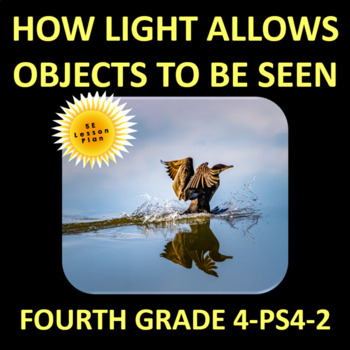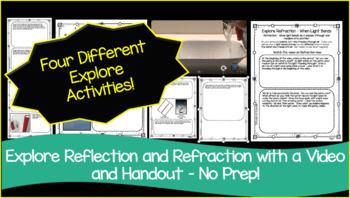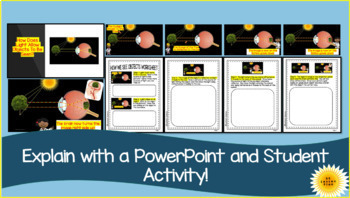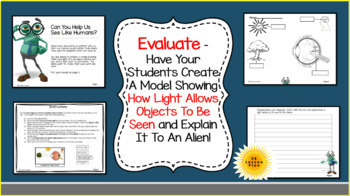NGSS 4-PS4-2 5E Lesson Plan How Light Waves Allows Objects to be Seen
- Zip
What educators are saying
Description
This 4th Grade 5E lesson plan on waves will have students make a model demonstrating how light falling on an object enters the eye and allows the object to be seen. It is designed to align to NGSS 4-PS4-2. We use inquiry - based activities to address the 5E lesson the following way:
Engage: Engage students with an inquiry-based PowerPoint and student worksheet.
Explore 1: Reflection – Students view images of reflection phenomena and complete a worksheet
Explore 2: Refraction – Students see a video of refraction phenomena and complete a worksheet. The video is MP4 file. No need to access YouTube.
Explore 3: Students complete a vocabulary activity
Explore 4: Students explore parts of the eye with a PowerPoint and complete a worksheet.
Explain: Students learn how the eye process light and sends images to the brain with PowerPoint and a student worksheet.
Elaborate: Students read a science literacy passage on how we see colors, and answer thought provoking questions in a worksheet.
Evaluate: A story line is created where students make a model to explain to an alien being how our eyes use light so objects can be seen.
Standards
This lesson is aligned with the following educational standards:
NGSS 4-PS4-2. Develop a model to describe that light reflecting from objects and entering the eye allows objects to be seen.
Disciplinary Core Idea:
PS4.B Electromagnetic Radiation - An object can be seen when light reflected from its surface enters the eyes. (4-PS4-2)
Science and Engineering Practices:
Developing and Using Models - Develop a model to describe phenomena. (4-PS4-2)
Crosscutting Concepts:
Cause and Effect - Cause and effect relationships are routinely identified.
Note: Next Generation Science Standards is a registered trademark of Achieve. Neither Achieve nor the lead states and partners that developed the Next Generation Science Standards were involved in the production of this product, and do not endorse it.”
Terms of Use
Copyright © Rushnok Science. All rights reserved. This product is to be used by the original downloader only. Copying for more than one teacher, classroom, department, school, or school system is prohibited. This product may not be distributed or displayed digitally for public view. Failure to comply is a copyright infringement and a violation of the Digital Millennium Copyright Act (DMCA). Any clipart or elements found in this product are copyrighted and cannot be extracted and used outside of this file without permission or license. Intended for classroom and personal use only. Multiple use licenses are available If needed for additional classes.





